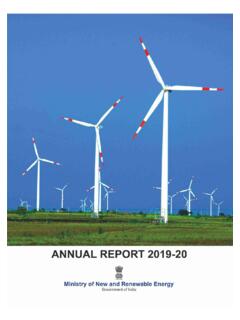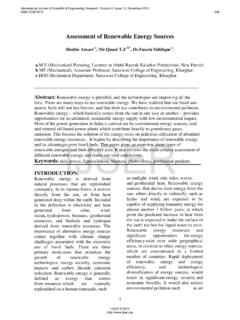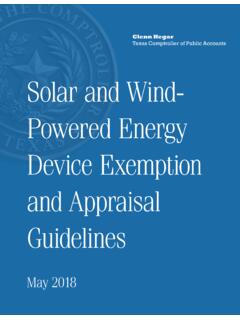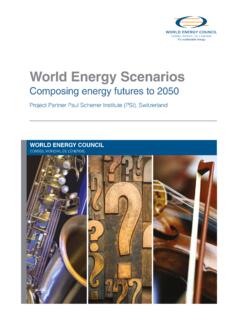Transcription of Renewable Energy Project Development: Advanced …
1 DOE OFFICE OF INDIAN Energy Renewable Energy Project development : Advanced process topics Understanding Energy Markets, Project Scale Decision Factors, Procurement Options, and the Role of the Project Team Course Outline What we will About the DOE Office of Indian Energy Education Initiative Processes for Developing Renewable Energy Projects on Tribal Lands - Understanding the Energy Market and Project Scale - Project Scale and Ownership Options - Procurement process - Project Team Additional Information and Resources 2 Introduction The Department of Energy (DOE) Office of Indian Energy Policy and Programs is responsible for assisting Tribes with Energy planning and development , infrastructure, Energy costs, and electrification of Indian lands and homes. As part of this commitment and on behalf of DOE, the Office of Indian Energy is leading education and capacity building efforts in Indian Country.
2 3 Training Program Objective and Approach A specially designed curriculum was created to give tribal leaders and professionals background information in Renewable Energy (RE) development to: Present foundational information on strategic Energy planning, grid basics, and Renewable Energy technologies Break down the components of the Project development process on the facility, commercial, and community scale Explain how the various financing structures can be practical for projects on tribal lands. 4 Course Audiences Tribal Leaders Primary decision makers Understand terminology Understand key decision points and factors influencing them Staff/ Project Management May be self-managing Project or managing consultants Communicate at key points with decision makers Require in-depth knowledge of process 5 How This Advanced /In-Depth Course Fits 6 Facility Comprehensive, in-depth process pathways for Project development and financing by Project scale Audience: Decision makers and Project and contract managers Community Comprehensive, in-depth process pathways for Project development and financing by Project scale Audience: Decision makers and Project and contract managers Commercial Comprehensive, in-depth process pathways for Project development and financing by Project scale Audience.
3 Decision makers and Project and contract managers Advanced /In-Depth Detailed, academic information for deep understanding of concepts Audience: Project and contract managers Essentials Basic process , decisions, and concepts for Project development Audience: All involved in Project Terminology in These Courses Why Is It Important? Provides common language for internal discussion Assists in interaction with external organizations Increases credibility in Project development What Does It Include? Common terms and language for Project development Acronyms for and roles of: Federal agencies Common federal and state policies Your resource for reference: DOE-IE Course Terminology Guide 7 8 Key Concepts In-depth information on each key concept available in Advanced Courses The Project Team Risk and Uncertainty Roles of the Tribe Levelized Cost of Energy (LCOE) Tax-Equity Partnership About the Speaker Jason Coughlin Project Leader at NREL with a primary focus on financing solar projects across all market segments Extensive experience with the request for proposal (RFP) and solar developer selection processes Has partnered with many local governments on public sector solar Project development Finance and banking background 9 Project development CONCEPTS: UNDERSTANDING THE Energy MARKET 10 Project Scale and Energy Markets Definition: Single building system Primary purpose.
4 Offset building Energy use Energy market: The Tribe Definition: Multiple buildings, campuses, parking lots Primary purpose: Offset community Energy costs Energy market: The Tribe Definition: Stand-alone utility-scale Project Primary purpose: Revenue derived from wholesale electricity sales or land lease Energy market: External 11 Photo credits: (left to right): NC Solar Center, NREL 09373; Orange County Convention Center, NREL 18077; Tucson Electric Power, NREL 13327 COMMUNITY COMMERCIAL FACILITY Understanding Energy Markets 12 A Renewable Energy Project is built with a particular market context Facility- or community-scale projects (distributed generation [DG]) are focused on interconnection, net metering, retail electricity rates and rate structures, and other local policies and regulations Commercial-scale projects require an understanding potential off-takers, regional wholesale electricity rates, access to transmission, conducting interconnection studies, determining need for grid upgrades, proximity to Renewable portfolio standard (RPS) markets, and the potential for material environmental and land-use permitting processes, among others Contracts will vary depending on the market context Refer to Electricity Grid Basics course for additional information Key Question.
5 What is the market for your electricity and how do you get it there? What Are the Potential Markets? On-site Facility- or Community-Scale The Tribe is the market but need to know what is allowed within a given utility territory Commercial-Scale Need an off-taker to buy your electricity A utility A large commercial, industrial, or government agency ( , military base) Utility motivated by RPS compliance Nonutilities motivated for a number of reasons, including: cost savings, sustainability goals, and Energy hedging 13 Renewable portfolio standard Renewable portfolio goal Source: * Extra credit for solar or customer-sited renewables Minimum solar or customer-sited requirement State RPS AZ 15% by 2025 CA 33% by 2020 CO 30% by 2020 (IOUs) 10% by 2020 (co-ops/munis)* MT 15% by 2015 NM 20% by 2020 (IOUs) 10% by 2020 (co-ops) NV 25% by 2025* OR 25% by 2025 (large utilities)* 5% 10% by 2025 (small utilities) WA 15% by 2020* UT GOAL: 20% by 2025 14 Identifying a Market.
6 Western States RPS Policies GenerationTransmissionDistribution13,200 volts345,000 voltsGenerating StationTransmission SubstationTransmission LinesSubtransmissionTransmission SubstationIndustrial CustomerDistribution SubstationCommercial/Residential Customers69,000 volts13,200 volts120/240volts480volts It is not enough to identify a market for the electricity Can you get the electricity to market? Existing transmission lines? Capacity on those lines? 15 The Electricity Grid Projected Transmission 16 California Projected to need an additional 400 13,000 MW installed by 2020 to meet RPS obligations No major projected transmission expansion in California Electricity Sales Total % US Res % US Comm % US Ind % Total US 19,000 GWh Policy Limit RPS 33% by 2020 Interconnection No Limit Net Metering 1 MW Major Utilities Los Angeles Department of Water & Power Pacific Gas & Electric Co. San Diego Gas & Electric Co.
7 Southern California Edison Co. Avg Elec. Prices (c/kWh) Retail (2012) Wholesale (2011) State TECHNICAL Potential (GW) Roof Solar Utility Solar CSP Wind Bio. Geo. 61 4,111 2,726 1,052 4 Tribal RESOURCE Potential (GW) Roof Solar Utility Solar CSP Wind Bio. Geo. ND .127 9 17 0% 0% 78% 22% % Consumers Served by Type of Utility in CA CooperativeFederalInvestor OwnedPublicOregon RPS obligations began in 2011 Projected to have 340 1,700 MW in excess of RPS obligations in 2020 Large projected transmission expansion across the state Electricity Sales Total % US Res % US Comm % US Ind % Total US 4,000 GWh Policy Limit RPS 25% (large utilities), 10% (small), 5% (smallest) by 2025 Interconnection No limit Net Metering 2 MW Major Utilities None Avg Elec. Prices (c/kWh) Retail (2012) Wholesale (2011) State TECHNICAL Potential (GW) Roof Solar Utility Solar CSP Wind Bio. Geo. 5 1,898 1,017 252 2 11% 0% 74% 15% % Consumers Served by Type of Utility in OR CooperativeFederalInvestor OwnedPublicTribal RESOURCE Potential (GW) Roof Solar Utility Solar CSP Wind Bio.
8 Geo. ND 7. 8 .0001 6 18 Summary: Understanding Electricity Markets Who Is Your Market? On-site Utility/utilities Nearby federal agencies (especially Department of Defense) Large commercial or industrial off-taker Getting Power to the Market Proximity to transmission Current capacity of existing transmission New transmission being planned Required transmission studies take time; start early Contracts Needed to Put It All Together Signed power purchase agreement (PPA) with creditworthy buyer Signed interconnection agreement Signed transmission agreement 19 20 Project development process : Project SCALE DECISION FACTORS Impacts of Project Scale Projects have different attributes depending on their scale The scale of Project drives financing options Transaction complexity increases with scale Two common roles for the Tribe would be the owner of the Project or the purchaser of the electricity through the use of the PPA 21 Project Scale Attributes Facility-Scale Community-Scale Commercial-Scale Likely Ownership Tribe Tribe or third-party developer/investor Third-party developer/investor Financial success metric Savings on utility bills (present and future) Savings on utility bills (present and future)
9 Positive cash flow for Tribe Relative Investment Low Medium High Level of Complexity Low Medium High Potential Jobs Impact Modest amount of construction jobs More construction jobs Potentially significant construction jobs Possibly O&M-related jobs Time Frame 1 6 months 6 18 months 18 months 5 years 22 Project Ownership Options Most common options: Direct tribal ownership Tax-equity partnerships 23 Direct Ownership Structure 24 Utility Payments Remaining Energy needs Over time, investment recouped from utility bill savings Tribe purchases a Renewable Energy system with its own funding Tribe and Electricity Users Project Primarily for facility- and Community-scale projects The Tribe is the owner in this structure and self-generates its electricity Ownership Options Direct Ownership 25 Advantages Maximum reduction in electricity bills Lower finance costs (or none depending on source) Full control over a Project .
10 Design, operations, and risks Own Renewable Energy credits (RECs) and can choose to retain or monetize Might be only option for small projects Challenges Need the resources to pay for the Project Don t fully benefit from available tax incentives given tax-exempt status Responsibilities of ownership (operations and maintenance [O&M]) 26 Tax- Equity Investor Tribe: Host and Purchase Fixed-Price Electricity (PPA) Site Access, $ Purchase Output Equity Investment $ Tax attributes: MACRS and either ITC or PTC Project Lends $ to the Project or Debt Capital $ Payments Lender/ Capital Provider Project Company/ Pass-Through Entity Corporations Tax Equity Utility $ Energy The Tribe is the host in this structure and agrees to buy electricity generated by the Renewable Energy system Primarily for community- and commercial-scale projects Tax-Equity Partnerships and Third-Party PPAs Tax-Equity Partnerships and Third-Party PPAs 27 Advantages No/low up-front outlay of capital Ability for tax-exempt entity to benefit from savings derived from tax-based incentives Fixed electricity price for 15 25 years No operating and maintenance responsibilities Path to ownership if desired Challenges The process of negotiating a PPA can be lengthy and costly Need to be able to enter into longer-term contracts (10 25 yrs)

















